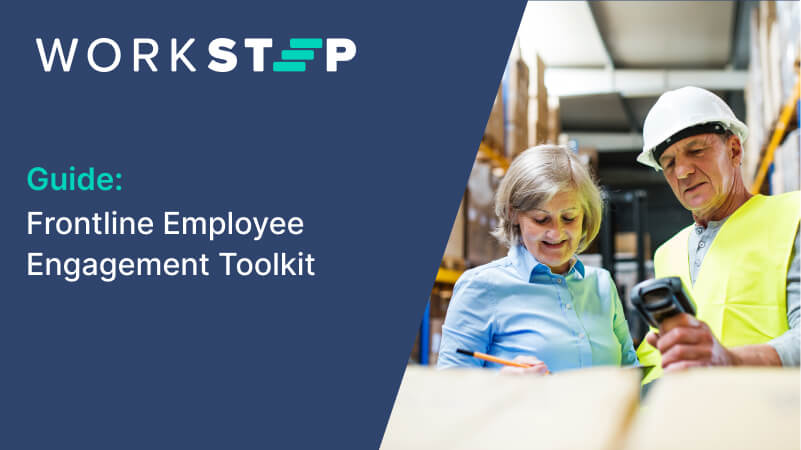If you’re in a leadership position within the supply chain, whether you’re in HR, operations or are a c-suite executive, then you know how important it is to retain your existing workforce. Not only is hiring new folks expensive, but you also are not likely to hire replacements with the same skill level or company knowledge.
Unlock the power of data-driven retention strategies with WorkStep’s innovative employee retention software. Our platform offers a comprehensive suite of tools to help supply chain companies improve employee satisfaction, reduce turnover rates, and drive business success.
Launching a retention strategy that is effective is difficult if you don’t gather the right metrics beforehand. Here are 10 retention KPIs that supply chain companies should focus on in order to successfully decrease their workforce turnover and drive positive outcomes for their frontline workers.
1. Overall employee retention rate
It’s important to determine the overall retention rate for a company or department in order to help gauge improvement. But how do you figure out what your retention rate is?
First look at how many employees you had at the beginning of the year. Then divide the number of employees remaining at the end of the year by that number. Multiply your answer by 100 and you have your retention rate.
2. Voluntary turnover rate
An organization’s voluntary turnover rate is the percentage of employees who leave their company by choice. Similar to determining your overall retention rate, you will want to divide the total number of employees into the number that left voluntarily and multiply that answer by 100. This will give you your voluntary retention rate.
A high voluntary turnover rate may indicate that there are areas that can be improved upon to increase employee satisfaction. Conducting regular check-ins with staff can help management understand where improvements should be made.
3. Involuntary turnover rate
When an employee leaves a company due to layoffs or for termination reasons, this is considered involuntary turnover. You’re probably getting the hang of how to calculate these rates by now, but just to be sure, to find your involuntary turnover rate, divide the number of employees that were laid off or terminated in a given date range into the total number of employees during that time and multiply the answer by 100.
Knowing your involuntary turnover rate can help you assess your hiring process, including recruiting strategies. If your rate is high, you may also want to evaluate your new hire training practices.
4. Retention per manager or department
Now that you have the numbers for voluntary and involuntary turnover, it’s time to look at if there is a concentration within a specific department or under a certain manager. If a large percentage or resignations or terminations fall under one location or person, you can begin by focusing your attention on those areas. Changes may need to be made in leadership or in training practices, or perhaps even in the hiring process.
5. Cost per hire
Understanding the cost of each hire can help you assess what the price is when an employee leaves the company and the investment in hiring someone new to replace them. These are numbers you will need to calculate how much turnover is costing your business and measure the ROI on any retention initiatives that are implemented.
6. Cost per turnover event
This metric is paramount in developing an effective retention strategy. Without understanding what the cost of each turnover event is, you won’t be able to measure your ROI on investing in retention efforts.
There are a lot of factors to consider when calculating this amount. You have to look at sourcing costs, salaries, incentive pay, benefits, new hire efficiencies, and other expenses. Luckily, WorkStep has created a Cost of Turnover Calculator that guides you through these calculations.
7. Employee satisfaction
Measuring employee satisfaction is an important element in understanding the reasons for employee turnover. It also helps companies develop a plan of action to make improvements that will have a positive outcome. If satisfaction is low, it’s likely a business will see an increase in turnover. This will ultimately affect the productivity of your workforce and your bottom line.
It’s tough to gauge employee satisfaction without a way to consistently gather feedback and measure how actions taken impact this satisfaction. WorkStep provides a platform to track employee satisfaction and drive frontline worker feedback across an entire organization and by facility, role, or department.
8. Employee engagement
How often is management engaging with their workforce to get feedback? If only annually or quarterly then you’re not getting an accurate assessment. Such infrequent check-ins leave holes of time where you may miss key people, such as those who have started a role and leave before having the chance to give feedback. These are exactly who you want to hear from to understand what is causing them to be unhappy in the role in hopes to prevent them from leaving.
Look at the cadence of engagement and measure how many employees participate and how many hires miss the opportunity to provide any input. You also want to examine how you are delivering communication to frontline workers. Does email or text get the best response?
9. DEI
DEI initiatives within an organization have been linked to increasing retention rates. In fact, 78% of employees say it’s important to work for an organization that prioritizes diversity and inclusion. That’s why it’s important to assess what your company is currently doing to support DE&I initiatives and look at ways this may be improved.
10. Average employment length
Determining what the average length of time an employee stays with your company can help leaders know what steps should be taken to increase this time. In order to measure this, add up the total number of years worked by your employees and divide that by the number of employees. This will give you the average employment length.
Once you have ascertained these 10 metrics you will be able to develop an effective retention strategy that will lead to an increase in productivity and improve your company’s bottom line.
Tune into your frontline with WorkStep
With the frontline employee engagement platform that delivers the real-time insights you need to take action, retain your workforce, and drive your business forward.
Kristina Finn, Content Marketing Manager | kristina@workstep.com



